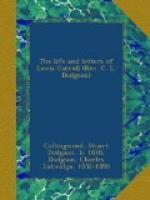His own drawings were in no way remarkable. Ruskin, whose advice he took on his artistic capabilities, told him that he had not enough talent to make it worth his while to devote much time to sketching, but every one who saw his photographs admired them. Considering the difficulties of the “wet process,” and the fact that he had a conscientious horror of “touching up” his negatives, the pictures he produced are quite wonderful. Some of them were shown to the Queen, who said that she admired them very much, and that they were “such as the Prince would have appreciated very highly, and taken much pleasure in.”
[Illustration: Holman Hunt. From a photograph by Lewis Carroll.]
On July 4, 1865, exactly three years after the memorable row up the river, Miss Alice Liddell received the first presentation copy of “Alice’s Adventures in Wonderland”: the second was sent to Princess Beatrice.
The first edition, which consisted of two thousand copies, was condemned by both author and illustrator, for the pictures did not come out well. All purchasers were accordingly asked to return their copies, and to send their names and addresses; a new edition was prepared, and distributed to those who had sent back their old copies, which the author gave away to various homes and hospitals. The substituted edition was a complete success, “a perfect piece of artistic printing,” as Mr. Dodgson called it. He hardly dared to hope that more than two thousand copies would be sold, and anticipated a considerable loss over the book. His surprise was great when edition after edition was demanded, and when he found that “Alice,” far from being a monetary failure, was bringing him in a very considerable income every year.
[Illustration: Sir John Millais. From a photograph by Lewis Carroll]
A rough comparison between “Alice’s Adventures Underground” and the book in its completed form, shows how slight were the alterations that Lewis Carroll thought it necessary to make.
The “Wonderland” is somewhat longer, but the general plan of the book, and the simplicity of diction, which is one of its principal charms, are unchanged. His memory was so good that I believe the story as he wrote it down was almost word for word the same that he had told in the boat. The whole idea came like an inspiration into his mind, and that sort of inspiration does not often come more than once in a lifetime. Nothing which he wrote afterwards had anything like the same amount of freshness, of wit, of real genius. The “Looking-Glass” most closely approached it in these qualities, but then it was only the following out of the same idea. The most ingenuous comparison of the two books I have seen was the answer of a little girl whom Lewis Carroll had asked if she had read them: “Oh yes, I’ve read both of them, and I think,” (this more slowly and thoughtfully) “I think ‘Through the Looking-Glass’ is more stupid than ‘Alice’s Adventures.’ Don’t you think so?”




